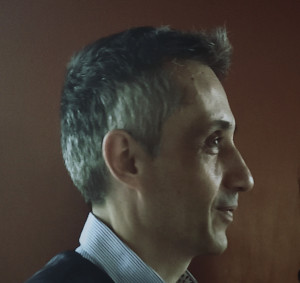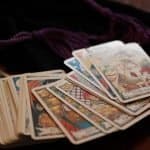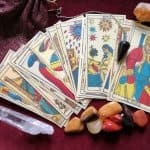Tarot cards are not only for divination, in fact, that is a secondary purpose. First and foremost Tarot cards have been developed as a device for enlightenment and wisdom. While there are many great books about Tarot on the market, this is my favorite list due to the abundance of knowledge they offer.
On the pages of these books, you can find the real history of the development of Tarot cards. In the first five books, you can learn directly from the personalities who contributed to the development of the Tarot. The last two books are well-researched works by modern scholars, about the history and evolution of Tarot.
These books addressed to the serious student of the Tarot and Occult sciences in general.
The Pictorial Key to the Tarot. By Arthur Edward Waite
A Classic Tarot Book.
The Waite-Rider deck is the most popular Tarot deck available today. The book was written in 1911 by the man who designed the cards, Arthur Edward Waite, while the work of art is by Pamela Coleman Smith.
It begins with a review of past theories about the origin of the Tarot and continues with an insight of the symbolism displayed on the cards. (Further reading: “Understanding the Esoteric Meaning of Major Arcana”)
Waite was a member of the Hermetic Order of the Golden Dawn, a “secret” society dedicated to maintaining occult knowledge. So this book can be difficult reading for those who are not familiar with western esotericism and occult symbology.
Many of his descriptions may seem unclear, but they are deliberately unclear. He held the belief that only people who had been initiated and studied for many years would be able to receive the most inner knowledge of Tarot cards. On the other hand, he gives a fairly detailed history of the cards.
Waite provides several “Divinatory Meanings” and some complicated spreads including his own “Celtic Cross” spread.
A difficulty in this book is the writing style. It is a combination of Victorian-style writing and occult terminology that can make it somewhat difficult to read.
“The Pictorial Key to The Tarot” is a great book for serious Tarot students and should be part of their library, but it is not recommended for someone who wants to learn to read the tarot for divination purposes only.
An Introduction to the Study of The Tarot: A Key to the Wisdom of the Ages. By Paul Foster Case
Essential for all serious students of the occult sciences.
Tarot is not just fortune telling, in fact, Tarot is mainly a tool for meditation and as such can reveal the secrets of the universe.
In this book, first published in 1947, Paul Foster Case explains in great depth the esoteric meanings of Major Arcana. As many students of the Western esoteric tradition have said, no one knows the Tarot better than Paul Foster Case.
He uses clear and precise language to provide depth information about the correspondences of the symbol, color, tone, zodiac, and number, as well as the working relationship between conscious, subconscious, and superconscious. All these are not only for barren knowledge but to be applied by the students in order to elevate their spirituality and their lives.
Paul Foster Case is the first to use the correct alignment of the Hebrew alphabet with the 22 cards of Major arcana and corrected previous miscalculations. Additionally, this was the first book to reveal the “Cube of Space” diagram, a system that most Occultists at that time didn’t even know.
Paul Foster Case was the founder of The “Builders of the Adytum” (B.O.T.A.), a school of Western mystery tradition based in Los Angeles, which has its roots in the Hermetic Order of the Golden Dawn and provides training in the Western Mystery Tradition, Tarot, Hermetic Cabala, Alchemy and meditation techniques. B.O.T.A continues to exist and has about 5000 members worldwide.
Certainly, this is not a book for beach reading. It is a book to read from cover to cover and is highly recommended for all serious students of the occult sciences.
Do you want to learn more about Tarot? Check out our recommendations at “Tarot Bookshelf” and many free resources at our “Free Tarot Library”
Tarot of the Magicians. By Oswald Wirth
Occult Symbols of the Major Arcana.
Oswald Wirth was a Swiss occultist and author. His book “Tarot of the Magicians” was first published in Paris in 1927, and later in 1985, the English version of Weiser was released.
Oswald Wirth provides a clear explanation of the Major arcana. His interpretations combine the symbolism of Alchemy, Rosicrucianism, Freemasonry, Egyptian and Chaldean magick, as well as astronomical associations.
The first part presents various tables to show the different correlations of cards and to clarify that there are different ways of understanding the hidden meaning of each card depending on the type of correlation we choose.
Oswald Wirth is another author who considers divination as a secondary purpose of tarot and refers to it only in the fourth part of the book and only in terms of intuition and imagination.
You must dedicate time to read and understand the deep concepts of Oswald Wirth, but it is one of the best books on the Tarot and must be in the library of all students of the occult.
The Book of Thoth. By Aleister Crowley
A must-have supplement to the Thoth Tarot.
Aleister Crowley, with the help of Frieda Harris, designed his tarot deck called “Thoth Tarot Deck”, in the 1920s. This book shares the same name and is the companion of the deck. For many students of occult sciences considered to be Crowley’s greatest contribution to occult literature.
The book contains not just a description of each card but goes into details about the correspondences of each suit and number with the zodiac signs, planets, colors, Qabalah, and Hebrew letters, along with allegories that explain specific details of the cards. However, Crowley seems to be discreet and does not share all his knowledge.
The Book of Thoth includes a section on the history and origin of tarot cards in general, and his deck specifically. It is very useful both, for divination purposes and for occult knowledge. His style of writing is a bit confusing, characteristic of the 19th century, but it is worth putting some time and effort into it.
In conclusion, “The Book of Thoth” is considered to be classical in the Tarot field and is essential reading for all students of the Western tradition.
The Tarot of the Bohemians. By Papus
19th-century French occult literature.
“The Tarot of the Bohemians” is a typical example of 19th-century French occult literature. It is a very complex book that goes far beyond Tarot cards.
Papus (Gérard Encausse) is one of the fathers of the Western esoteric tradition. It is not easy to follow his thinking but the esoteric knowledge that he shares is profound and abundant. (Further reading: “Understanding the Esoteric Meaning of Major Arcana”)
His interpretation system is based on the Tetragrammaton, while he associates the cards with hermetic ideas, numerology, seasons, astrology, and Hebrew letters. His ideas about the origins of the Tarot (bohemians, Ancient Egypt, India), nowadays are unsubstantiated.
This book is not for beginners and, for sure, takes a lot of time to study and assimilate the knowledge that Papus shares. However, it is one of the best books for those who are interested in esoteric knowledge and history.
So, don’t neglect it because of its difficulty in reading, but put the effort to study it and I’m sure you will be rewarded with an abundance of occult knowledge and understanding.
A Cultural History of Tarot: From Entertainment to Esotericism. By Helen Farley.
A deeply researched history, without unsustainable theories.
The book “A Cultural History of Tarot”, shows the journey of tarot cards from Italy in the 14th century, which were used as recreational playing cards, to French and England in the 18th and 19th centuries, where became associated with esoterism, and later in the 20th century until now, where became foremost a medium for divination.
Helen Farley wrote a deeply researched, erudite, and highly useful book for everyone interested in the history of tarot. It is an academic work with an extensive bibliography and numerous citations, yet it is readable for any reader. (Further reading: Comprehensive Timeline of Tarot History – 14th to 19th Century.)
The main point of the book is the evolution of Tarot cards from a game into an esoteric device for personal transformation and divination. In addition, Farley explores the various ways in which Tarot interacted with culture while mentioning cards’ associations with astrology, Kabbalah, and many schools of esoterism, over time.
Her study includes archival studies in Milan and London, theories and studies of other scholars, until the latest “New Age” Tarot phenomenon. The plethora of biographical citations helps the reader to find more information about anything that he wants more clarification on but is not directly related to Tarot like the Italian society and politics, the renaissance, Catholic Church e.t.c
In conclusion, the “A Cultural History of Tarot”, is for anyone who wants to read about the actual history of the Tarot with historical evidence and without unsustainable theories.
Do you want to learn more about Tarot? Check out our recommendations at “Tarot Bookshelf” and many free resources at our “Free Tarot Library”
A History of the Occult Tarot. By Ronald Decker and Michael Dummett
This is a great book on Tarot History.
Ronald Decker and Michael Dummett wrote one of the most concise histories of the western occult tradition. While it is a comprehensive examination of the 19th and 20th-century Tarot cards, they also provide important information about the various occult groups of this period.
It is not a book for tarot readers, but an excellent resource for anyone who likes to know more about the history of occult sciences.
The authors examine how the Tarot went from playing cards, used only for entertainment, to being the favored divination device of many occultists. They address the way Tarot cards were developed over time and their use of them by occult practitioners, while they spend some time on the explanation of ceremonial magick and Kabbalah.
This book includes a well-presented background of the occult organizations which adopted the Tarot during that period. Occult groups like the Theosophical Society, the Golden Dawn, the Hermetic Brotherhood of Luxor even the Church of Light referred with enough details, providing additional knowledge to every student of the occult.
It should be noted that not only the major but also less known personalities and occult groups have their place in this book.
As we mentioned earlier this is not a book on how to read tarot cards. It is a very impressive book about the history of Tarot, including the personalities and the occult groups that contributed to its development. It is a must-read for all occult students and Tarot enthusiasts.
(Further reading: Comprehensive Timeline of Tarot History – 14th to 19th Century.)
Stay in Touch
 Join our newsletter by using the forms on this website or click here!
Join our newsletter by using the forms on this website or click here! Follow us on Google News
Follow us on Google News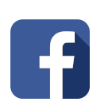 Follow us on Facebook
Follow us on Facebook
Feature Image by Pxhere.com

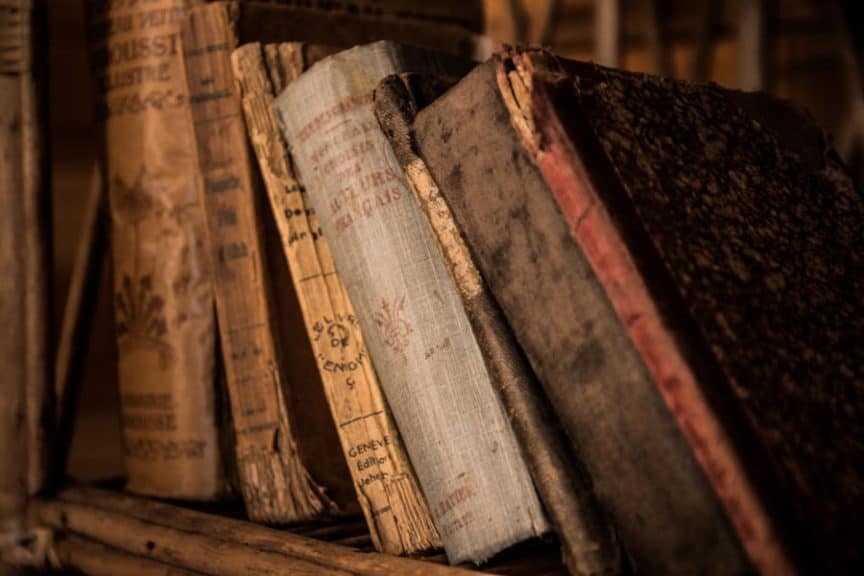






![History of the Occult Tarot by Dummett, Michael, Decker, Ronald [Duckworth Publishing,2002] [Hardcover]](https://m.media-amazon.com/images/I/511ToU+oLEL._SL500_.jpg)
